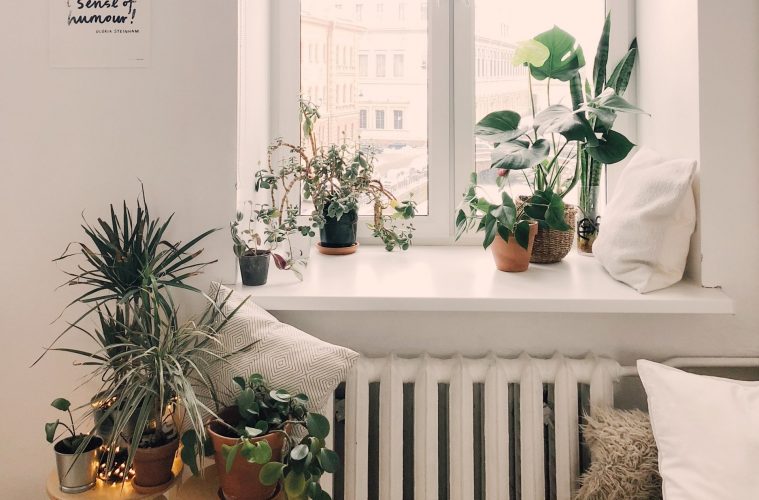Indoor plants provide a lot more than living beauty.
A little too chilly to head out into the garden, but miss pottering around among your plants? Indoor gardening can help your mental and physical health. Seriously, there are many plants that can purify the air in your home, on top of providing a calming atmosphere.
Basket case
Devil’s ivy (Epipremnum aureum), also known as golden pothos, is a cascading vine that can help clear formaldehyde and carbon monoxide from the air, according to research
done by Nasa into the air-purifying properties of indoor plants. Place it on a high shelf or in a hanging basket and enjoy the cascade of light green leaves tumbling down. It’s the perfect indoor plant, even for those who claim they are unable to keep house plants alive, as it is extremely tolerant. The hen-and-chickens or spider plant (Chlorophytum comosum) is another air-purifying plant that will provide a softening green flow to your indoor decor. With its arching clumps of variegated leaves and baby plants that dangle on the ends of protruding stems, it helps minimise sharp indoor contours such as corners and shelves. These plants are great at combatting pollutants, including xylene benzene, formaldehyde and carbon monoxide. The Philodendron scandens is commonly known as the sweetheart plant, due to its heart-shaped leaves. This glossy green climber is good at cleaning the air and absorbing toxic fumes. If you want it to climb, you’ll need to provide it with some trellising or other form of support, otherwise it will drape downwards.
Long lines
To add a different element indoors, look for plants that draw the eye upwards while still filling the area with lush greenery. The classic rubber tree (Ficus elastica) is hard to beat for both its toughness and ease of growth – it is happy even in dim light. Another air purifier, it is an enthusiastic grower and can get quite large, so may not beideal for small homes. However, you can keep it under control for many years with careful pruning. Sansevieria trifasciata, known by the unfortunate name mother-in-law’s tongue, filters out formaldehyde, which is found in things like tissue paper and cleaning products. Keeping it in your bathroom is a good idea, as it is quite low-maintenance and its grey-green marbled leaves, with white- or yellow tinged edges, add interesting colour. The mother-in-law’s tongue can look different depending on the colour of the background wall. It’s long, lean lines make an architectural statement, but you may find that just a single plant looks a bit stark. Consider grouping it with other plants or positioning three together for a fuller look.
Add some drama with the red-edged dracaena (Dracaena marginata) that, as its name suggests, has green leaves edged with a distinctive red border. It can grow tall if it gets lots of sun, often reaching right to the ceiling. Keep the pruning shears handy and prevent it from becoming long and lanky. Trim off the long canes and the new shoots will sprout out near the cut, making the plant bushier. People with small children and pets may want to avoid the dracaena, however, as it contains toxic compounds, saponins, which can cause vomiting.
Retro appeal
They became popular as indoor plants in the ’70s, and now bamboos and ferns are making a comeback – but with a twist: contrast combinations. Think of covering an entire shelf or wall with a variety of different ferns interspersed with bright bromeliads (Bromeliaceae). Or try mixing the fluffy stubby fingers of the local asparagus fern (Asparagus densiflorus) or the large, clumping sword or Boston fern (Nephrolepis
exaltata) with the feathery leaves and tall canes of bamboo plants. Ferns such as the dwarf tree fern (Blechnum gibbum) and succulents such as indigenous bulbine together
will provide a striking contrast in texture and height.
Colour me pretty
You don’t have to stick to green. Add colour to your indoor garden with flowering plants such as peace lilies (Spathiphyllum); although not a true lily, it bears some resemblance to an arum lily and can add lovely touches of white. Don’t forget evergreen favourites like the African violets (Saintpaulia) that will flower all year round in the right conditions. They need bright but not direct sunlight, a spot that doesn’t catch a draft and warm water in small amounts. Always keep an eye open for what’s on offer at your local nursery and add a fresh flowering pot plant appropriate to the season.
[Image via Pexels]


